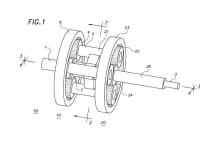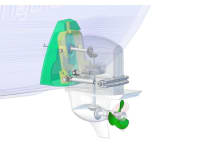
Currently, propeller pitch control uses three approaches: it is based upon either hydraulic oil pressure, mechanical control using lateral motion along the axis of the drive shaft, or electric motor control with the drive motor embedded in the hub. All three of these techniques are either expensive to manufacture and install, or expensive to maintain due to high wear rates or the close machine tolerances required.
The First Image is a conceptual sketch of the Angular Motion Translator (AMT), US patent 6,547,689. The AMT is a mirrored planetary gear system that allows the angular relationship between two non-rotating parts to be translated into an identical angular relationship between two rotating parts, all with a direct, geartooth-to-geartooth, mechanical connection. The AMT works as follows: the annulus gears on both planetary systems are held motionless except when an angular differential is initiated. The AMT input shaft is connected to the input sun gear and is the output shaft. The input sun gear drives the input planetary gears against the input annular gear. Input planetary gears rotate the output planetary gears through the planet intercarrier. The output planetary gears drive the output sun gear by working off of the static output annulus gear. The output sun gear is connected to the output tube mounted over the output shaft. The output tube and shaft will rotate at the same speed, and the output tube will have added to its motion any change in the angular relationship between the two annulus gears.
The Second Image shows the AMT used to drive a variable pitch boat prop. When the two shaft motion is applied as an integral component of a propeller hub, the AMT allows for precise, directly mechanical control of blade pitch. Additionally, since all contact is either through gearteeth or ball bearings, the wear rates will be no more like that of a standard gearbox. The blade pitch can be altered very quickly, allowing the pitch controller to rapidly accommodate changes in loading while keeping the engine and the propeller operating at maximum efficiency under varying conditions. Also, the AMT/Blade control mechanism can be designed to allow for reverse pitch.
The Third Image shows the complete assembly for an inboard/outboard assembly.
The AMT, then, provides an inexpensive means to precisely and rapidly regulate the pitch of a propeller.
-
Awards
-
 2012 Top 100 Entries
2012 Top 100 Entries
Like this entry?
-
About the Entrant
- Name:Paul Baker
- Type of entry:individual
- Software used for this entry:AutoCAD, Alibre Design
- Patent status:patented
















